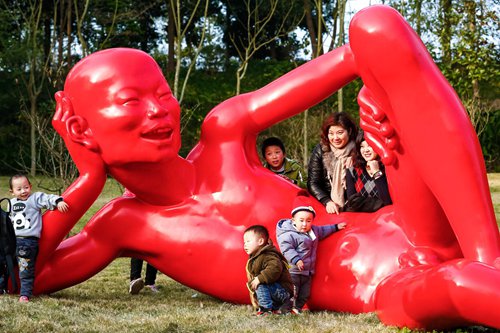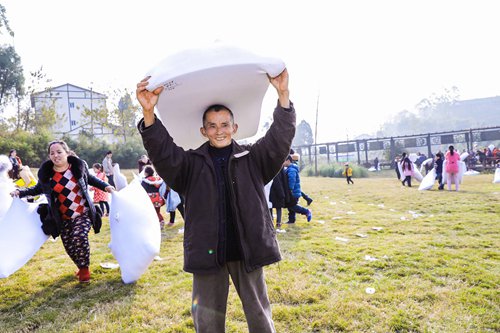ARTS / ART
Guang’an Field Art Biennale pays tribute to China’s village culture

Visitors take photo with one of Chen Wenling's Red Memory statues in Fangjiagou village, Sichuan Province on Sunday. Photos: Courtesy of Mi Nuo

A local resident of Fangjiagou village poses for a picture with a puzzle piece from the artwork Antarctica by Yin Xiuzhen. Photos: Courtesy of Mi Nuo
If there was a competition for worst places to hold an artwork display, then the chosen location of the Guang'an Field Art Biennale would definitely be on the list. Set up outside in a field near Fortress Baozhen in the village of Fangjiagou, Sichuan Province, the biennale doesn't have any fancy lighting or dedicated curation and the artworks are exposed to the elements as there are not even any shelters to house them. Visitors even have to walk down a muddy path to just get to the exhibits.While this may sound horrible, it hasn't curbed the enthusiasm of the local residents, many of whom have been overjoyed to be so close to contemporary art. After the biennale opened on Sunday, one exhibit even "went missing" because some enthusiastic visitors took the artworks on display home with them.
"Cities are ideal places for exhibitions, but we still need people to challenge this idea," said Yi Shan, one of the biennale's founders, when asked why he wanted to hold an art exhibition in a rural area.
According to Yi, his goal is to meet rural people's demand for culture by creating a platform that combines urban and rural artistic resources together.
The event is set to run until May 10, 2019.
Local inspiration
One advantage of holding an event like this outside of major metropolises is that China's rural areas are full of numerous local folk tales and legends, which act as rich resources of inspiration for artists to draw upon.
Inspired by a local folk tale, Chinese artist Wang Du decided to create an installation work that sees visitors explore an "archeological site" to unearth an important item belonging to the "Dragon Girl" of local legend.
In Wang's version of the tale, the Dragon Girl would often dress as a human to explore the mortal realm. However, she had to take care while traveling as she would immediately revert to her natural state if she came into contact with any "vulgar" object. Despite her extreme care, one day an accident causes her to come into contact with one such object. Fleeing to a river before she changes back, the Dragon Girl loses her hair clasp, the only remaining memento of her mother.
"Luckily enough," this object has been "discovered" by the artist and his team.
"The key to this exhibit lies in how it builds on local culture and society and how it interacts with them using artistic language. If we bring something from another place, that sort of destroys the local environment, so any artwork must be something that grows from here. This is why, when I visited here before, I talked with locals to collect some folk tales and ghost stories," Wang explained.
Chinese artist Sun Yuan's Hypothesis Biography also draws on local elements, specifically the fort's military nature and its closeness to the nearby city of Chongqing, the wartime capital of the Republic of China (1912-49) during the War of Resistance Against Japanese Aggression (1931-45).
Sun has placed an antiaircraft gun and an airplane propeller in Fort Baozhen to tell visitors of a fictional war time story in which the fort comes under air attack during the war.
In the story created for the installation, a militia led by the real-life local Duan family carries out a resistance movement against the Japanese military. In 1943, the Duan family regiment manages to successfully shoot down a Japanese Zero fighter with air defense fire, killing the Japanese pilot. To commemorate the battle, the downed plane and the 130 antiaircraft guns used by the militia are preserved for future generations - represented by the propeller and antiaircraft gun on display.
The weapon on display, while real, is not actually from World War II. According to Sun, he couldn't find a weapon dating from the war, so he bought another type used during the 1970s on online shopping platform Taobao. This weapon of war has now been turned into something else entirely as local kids and visiting tourists have fun playing with it.
Rare opportunity
The event has been a great opportunity for locals to learn more about contemporary art, and even try their hand at art criticism.
Walking around artist Chen Wenling's Red Memory art installation - a giant statue of a bright red naked man relaxing on the ground with a smile on his face - a 50-something local resident surnamed Deng told the Global Times that he finds the bright red color appealing, but thinks the man would look better if he wore a pair of pants.
This biennale has also given residents the rare chance to come into contact with foreign art.
Interactive installation work Wonderful World of Abstraction from Swedish artist Jacob Dahlgren has become one of the most popular exhibits among locals.
Numerous canvas painted with geometric stripes come together to form a large tent-shaped structure.
From the outside, the work dazzles visitors' eyes, and stepping inside they disappear into a sea of multicolored satin strips, becoming invisible to everyone around them.
According to the artist, the goal of the artwork is to cause visitors to lose their sense of direction.
Visiting German art critic Claus Mewes commented that the biennale succeeds because of the way it incorporates local art traditions and finds a balance between technology and nature and people's desire for stimulation, education and aesthetic experiences.

